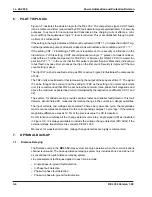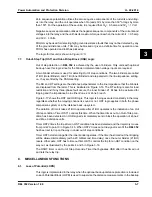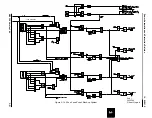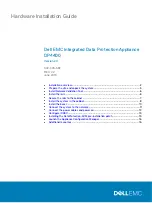
Power Automation and Protection Division
I.L. 40-201.9
REL 352 Version 1.00
3-7
3
Zero sequence polarization utilizes the zero sequence components of the currents and voltag-
es into the relay, and the unit operates when 3Io leads 3V
0
by more than 30
°
or lags by more
than 150
°
. For the operation of these units, it is required that 3I
0
> 0.5 amp and 3V
0
> 1 Volt.
Negative sequence polarization utilizes the negative sequence components of the currents and
voltages into the relay and the unit has its maximum torque line when the current 3I
2
> 0.5 amp
and 3V
2
> 3 Volts.
FDOG may be used for detecting high ground resistance faults that may not be detected by any
of the ground distance units. TOG may be blocked or given a definite time for operation once
FDOG has operated and IoM has picked up.
The logic for this unit is shown in
Figure 3-15.
7.7.
Out-of-Step Trip (OST) and Out-of-Step Block (OSB) Logic
Out of step detection in REL 352 is achieved by the use of blinders. Only units with optional
back-up have this logic since for the blinder implementation voltage inputs are required.
A two blinder scheme is used for detecting Out of step conditions. The two blinders are called
21 BO (Outer Blinder) and 21 BI (Inner Blinder) and are parallel to the line impedance setting,
i.e., they are tilted by the PANG setting.
The RU and RT settings are the distance perpendicular to the line impedance that the blinders
are displaced from the latter. This is illustrated in Figure 3-16. The RT setting is also for load
restriction and if any three-phase fault occurs, the inner blinder, 21 BI has to be activated for
tripping and the impedance be in either Zone 2 or Zone 3 reach.
Figure 3-17 shows the OST and OSB logic. This logic is being executed constantly in the relay
regardless whether the relaying channel is sound or not. OST logic applies in both the phase
comparison system or in the distance back-up system.
The duration of time it takes 21 BI to operate after 21 BO operates is the indication of an Out
of Step condition. Timer OST1 controls this time. When the timer times out, an Out of Step con-
dition has been detected. An OSB signal is immediately sent to block the operation of Zone 2
and Zone 3 distance units.
Timer OST2 times the trip after an OST condition has been detected and the trajectory moves
from point 2 to point 3 in Figure 3-16. When OST 2 times out a trip signal is sent if the REL 352
has been set to trip on the way in under out of step conditions.
Timer OST3 starts timing after the inner blinder operates. If the timer has timed out then tripping
will be allowed immediately (with a 20 millisecond time delay) once the outer blinder (21 BO)
resets. Other wise, OST has to time out first. OST3 controls the trip for an OST condition on the
way out, as illustrated by the points 4 and 5 in Figure 3-16.
The OSOT timer is an Out of Step Over-ride Timer that bypasses OSB after it has timed out
and lets the relay trip.
8.
MISCELLANEOUS FUNCTIONS
8.1.
Loss of Potential (LOPB)
This logic is implemented in the relay when the optional back-up distance protection is included.
Loss-of-Potential Block (LOPB) is used to supervise the distance measurements in the backup
















































